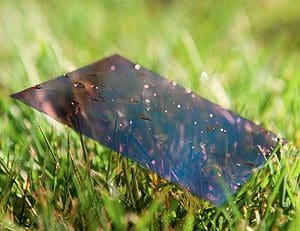One of the cutting edge technologies currently used today in manufacturing allows for printing materials directly onto a surface to create electrically functioning devices which are very thin and flexible. The best example of such an application are organic light-emitting diodes (OLEDs), widely used as displays for most new generation smartphones commercially available now. The process however is very tedious, and the resulting devices become vulnerable to outside chemical phenomena, thus the need for an extra isolating casing, which makes the process expensive and the resulting device thicker.
Scientists at Georgia Tech may have finally devised a work-around this issue after they introduced a printed electronics atypical conductor with a low-work function by applying thin layer of polymer coating on the conductor’s surface. This makes it safe for use in ambient conditions, as well as efficient.

Typically, printed electronics, an industry set to grow by tens of billions of dollars over the next 10 years, create light or energy ultimately needed to display information on a screen by injecting or collecting electrons. The technology used today employs conductors like calcium, magnesium or lithium, which are highly chemically reactive materials. When exposed to oxygen or humidity, these metals oxidize and cease to function, so for the printed electronics to stably work they must be covered with a rigid, thick barrier such as glass or expensive encapsulation layers.
Scientists have sought to replace these materials with ones that can work exposed to ambient conditions, however the ones currently in use have been deemed the best options because of their low-work function, the prime prerequisite for workable printed electronics. The work function is the minimum energy needed to remove an electron from a solid to a point immediately outside the solid surface.
Here’s where the Georgia Tech researchers reached their potentially industry shaping breakthrough. The scientists managed to reduce the work function of a conductor by applying a very thin layer of a polymer, approximately one to 10 nanometers thick, to its surface to create a strong surface dipole. This interaction dramatically lowers the work function of conductors, which function without any issues exposed to air, but which couldn’t have been used in printable electronics until now. Best of all, the technique is universal and totally inexpensive, making use of polymers already commercially available.
“These polymers are inexpensive, environmentally friendly and compatible with existent roll-to-roll mass production techniques,” said Bernard Kippelen, director of Georgia Tech’s Center for Organic Photonics and Electronics (COPE). “Replacing the reactive metals with stable conductors, including conducting polymers, completely changes the requirements of how electronics are manufactured and protected. Their use can pave the way for lower cost and more flexible devices.”
To demonstrate their research’s findings, the Georgia Tech scientists built the first-ever, completely plastic solar cell and also evaluated the polymers’ performance in organic thin-film transistors and OLEDs, presented in their paper recently published in the journal Science.
“The polymer modifier reduces the work function in a wide range of conductors, including silver, gold and aluminum,” noted Seth Marder, associate director of COPE and professor in the School of Chemistry and Biochemistry. “The process is also effective in transparent metal-oxides and graphene.”
What this means is that soon enough, TVs as thin as a sheet of paper or more reliable solar cells might become commercially available at an affordable cost.






